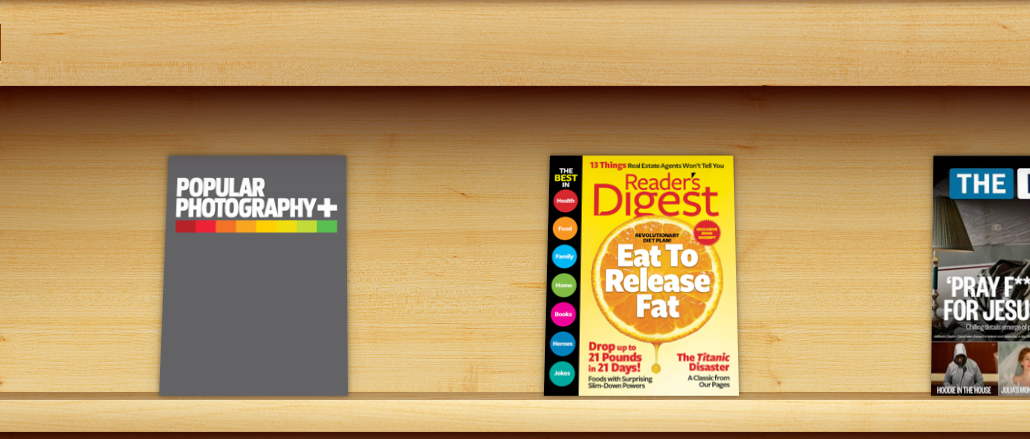
Magazine publishers have a tablet problem. According to one designer, they always have. Four years after Apple introduced the iPad, tablet apps are stagnating. A combination of design, pricing and discovery issues has made tablet magazines a hard sell, both for publishers and the digital readers they’re trying to reach.
“There are still a lot of issues,” said Joe Zeff, vice president of tablet app software company ScrollMotion, who helped launch apps for Fast Company and National Geographic.”These magazines are too hard to deliver, issues take a long time to download, and Apple’s Newsstand doesn’t make them easy to find. There are just too many things that have to go right.”
There was a time, not so long ago in the grand scheme, when the iPad was thought to be the savior of digital publishing. Magazines rushed out digital editions, many of which were flawed in both their pricing and in technology. The promised manna did not materialize. And now tablet sales are plateauing.
Zeff said that while publishers still have a lot of work to do with tablet apps, hope isn’t lost. Digiday spoke to him the magazine app’s successes, its failures, and why publishers should think of themselves as utilities.
Tablet magazines were supposed to save publishing. What went wrong?
The tablet magazine has been flawed from the start. They were conceived based on what publishers wanted and not what consumers wanted, so there was a lot of emphasis on extending old work flows and old reading habits rather than creating new products. We had the opportunity to put magazines on computers, which should have made magazines smarter. And that hasn’t really happened.
Are there any success stories?
There are some tremendous ones being created, yes. Wired is always a lot of fun, and Hearst, overall, seems to be doing a pretty good job at selling subscriptions, but I’d say that the success stories are few and far between.
Is this something that publishers can turn around? What are the opportunities?
There are some real opportunities to rethink the idea of a tablet magazine in order to recreate something that’s compelling. A tablet magazine should be smarter than the current set of publications. They should give me options about what content I receive and how and when it’s delivered. To do that, content has to be more modular. Today content is wrapped up in a magazine format, where everybody gets the same product. It really should be mixed and matched based on what works for me, not what works for the publisher. Content should be tied to where I am and what I’m doing, and become much more part of my regular routine.
That’s not happening now. Now, I’m getting a magazine that is very similar to what I can get anywhere else, and it’s not been created for me. It’s been created and looks in a way that suits the publisher, not the consumer.
What you’re describing sounds like Flipboard or Zite, which let people curate content from multiple publishers. Is this another situation where you have to ask why publishers didn’t create something like these apps themselves?
That’s a reality that publishers are going to have to confront. The content that consumers want is not restricted to any one source. The Web is doing a really great job at curating content and giving people choices, and that’s not how the technology behind tablets is being deployed. Also, tablets have Web browsers, and those Web browsers have HTML content that for the most part does a perfectly good job of presenting the content.
Wasn’t some of this what The Daily was supposed to do? It was digital first, it was interactive and it was made specifically for the iPad. That didn’t do well either.
The Daily was a bit early. What were seeing today is that people are accustomed to using the web to acquire content that happens to be free, and using apps because they want to do something.Tablet magazines, generally speaking, don’t do anything except show content that I can get somewhere else with less hassle and less cost.
Can publishers ever turn things around?
If you can make an app useful and give me some value behind that content, I’ll use the app every day, and I might even pay you for it. The next frontier for publishers is to figure out a way to tie content and utility and leverage the functionality of devices to truly make their content more useful.
I can envision an application of iBeacon that relates to shopping. My device knows who I am, and it knows that I am entering the shoe department. The iBeacon sends relevant content from GQ magazine to my device about which shoe styles are in fashion. The ability to deliver content at opportune moments is something that could be game-changing for publishers.”
But that’s a vision of publishing that’s only partially about publishing as we understand it now.
Content is a part of the puzzle; the other part is utility, and I don’t see the publishing industry driving innovation there right now.
More in Media

Digiday+ Research: Publishers’ growing focus on video doesn’t translate to social platforms
Major publishers have made recent investments in vertical video, but that shift is not carrying over to social media platforms.

Technology x humanity: A conversation with Dayforce’s Amy Capellanti-Wolf
Capellanti-Wolf shared insight on everything from navigating AI adoption and combating burnout to rethinking talent strategies.

How The Arena Group is rewriting its commercial playbook for the zero-click era
The company is testing AI-powered content recommendation models to keep readers moving through its network of sites and, in doing so, bump up revenue per session – its core performance metric.





